
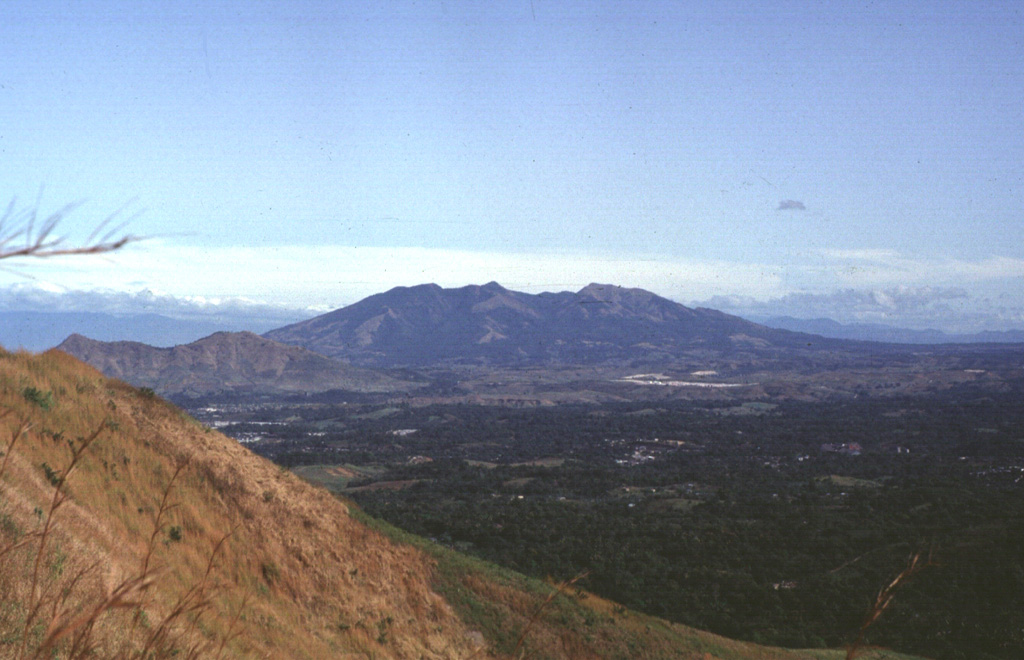
The Global Volcanism Program has no activity reports available for Guazapa.
The Global Volcanism Program has no Weekly Reports available for Guazapa.
The Global Volcanism Program has no Bulletin Reports available for Guazapa.
|
|
||||||||||||||||||||||||||
The Global Volcanism Program is not aware of any Holocene eruptions from Guazapa. If this volcano has had large eruptions (VEI >= 4) prior to 12,000 years ago, information might be found on the Guazapa page in the LaMEVE (Large Magnitude Explosive Volcanic Eruptions) database, a part of the Volcano Global Risk Identification and Analysis Project (VOGRIPA).
This compilation of synonyms and subsidiary features may not be comprehensive. Features are organized into four major categories: Cones, Craters, Domes, and Thermal Features. Synonyms of features appear indented below the primary name. In some cases additional feature type, elevation, or location details are provided.
Cones |
||||
| Feature Name | Feature Type | Elevation | Latitude | Longitude |
| Macanze, Cerro
Nacanze, Cerro |
Pyroclastic cone | 776 m | 13° 51' 43.00" N | 89° 3' 48.00" W |
| Tecomatepe, Cerro | Stratovolcano | 1003 m | 13° 50' 35.00" N | 89° 3' 9.00" W |
 Guazapa is an eroded Pleistocene volcano NE of the capital city of San Salvador, and is seen here from the SW. There are several relatively young cones and lava flows of similar composition around the lower flanks.
Guazapa is an eroded Pleistocene volcano NE of the capital city of San Salvador, and is seen here from the SW. There are several relatively young cones and lava flows of similar composition around the lower flanks.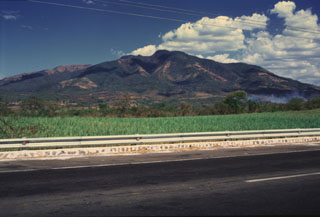 Guazapa is seen here from the west, 3 km NE of the town of Guazapa. This eroded Pleistocene cone is one of the largest of the interior valley of El Salvador. Deep erosional valleys have formed down the flanks, and younger cones and lava flows are found around its base.
Guazapa is seen here from the west, 3 km NE of the town of Guazapa. This eroded Pleistocene cone is one of the largest of the interior valley of El Salvador. Deep erosional valleys have formed down the flanks, and younger cones and lava flows are found around its base.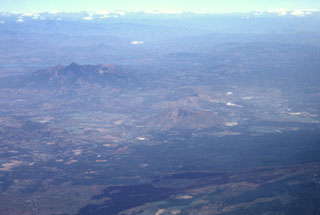 The massive Pleistocene Guazapa stratovolcano (left-center) is seen here in an aerial view from the SW with the Río Lempa behind it. The youngest flank vent of Guazapa is Cerro Macanze, which lies on the SE flank of the volcano, behind the two small volcanoes in the right-center part of the photo. The dark-colored unvegetated lava flow in the foreground was erupted in 1917 from the flank of San Salvador volcano.
The massive Pleistocene Guazapa stratovolcano (left-center) is seen here in an aerial view from the SW with the Río Lempa behind it. The youngest flank vent of Guazapa is Cerro Macanze, which lies on the SE flank of the volcano, behind the two small volcanoes in the right-center part of the photo. The dark-colored unvegetated lava flow in the foreground was erupted in 1917 from the flank of San Salvador volcano.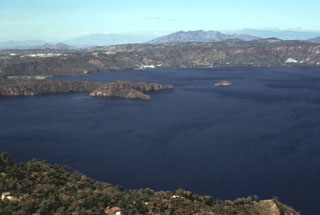 The western side of Lake Ilopango is seen from the southern rim of Ilopango caldera. The broad peak on the right-hand horizon is the Pleistocene Guazapa volcano. The northern wall of Ilopango caldera rises about 400-500 m above the lake. Much of the caldera rim contains thick caldera-forming eruption deposits, and some lava domes are exposed in the caldera wall.
The western side of Lake Ilopango is seen from the southern rim of Ilopango caldera. The broad peak on the right-hand horizon is the Pleistocene Guazapa volcano. The northern wall of Ilopango caldera rises about 400-500 m above the lake. Much of the caldera rim contains thick caldera-forming eruption deposits, and some lava domes are exposed in the caldera wall.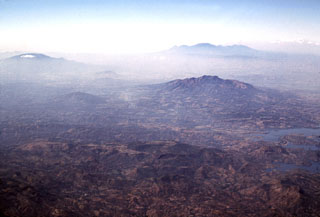 Volcán de Guazapa (near the center) rises beyond the Cerrón Grande reservoir (lower right) in this view from the NE. The smaller cone to the left of Guazapa is Cerro Tecomatepe. San Salvador volcano is to the upper left, the Santa Ana complex is the broad massif at the upper right, and peaks of the Sierra Apaneca near the Guatemalan border form the irregular ridge to the far right.
Volcán de Guazapa (near the center) rises beyond the Cerrón Grande reservoir (lower right) in this view from the NE. The smaller cone to the left of Guazapa is Cerro Tecomatepe. San Salvador volcano is to the upper left, the Santa Ana complex is the broad massif at the upper right, and peaks of the Sierra Apaneca near the Guatemalan border form the irregular ridge to the far right.There are no samples for Guazapa in the Smithsonian's NMNH Department of Mineral Sciences Rock and Ore collection.
| Copernicus Browser | The Copernicus Browser replaced the Sentinel Hub Playground browser in 2023, to provide access to Earth observation archives from the Copernicus Data Space Ecosystem, the main distribution platform for data from the EU Copernicus missions. |
|
WOVOdat
Single Volcano View Temporal Evolution of Unrest Side by Side Volcanoes |
WOVOdat is a database of volcanic unrest; instrumentally and visually recorded changes in seismicity, ground deformation, gas emission, and other parameters from their normal baselines. It is sponsored by the World Organization of Volcano Observatories (WOVO) and presently hosted at the Earth Observatory of Singapore.
GVMID Data on Volcano Monitoring Infrastructure The Global Volcano Monitoring Infrastructure Database GVMID, is aimed at documenting and improving capabilities of volcano monitoring from the ground and space. GVMID should provide a snapshot and baseline view of the techniques and instrumentation that are in place at various volcanoes, which can be use by volcano observatories as reference to setup new monitoring system or improving networks at a specific volcano. These data will allow identification of what monitoring gaps exist, which can be then targeted by remote sensing infrastructure and future instrument deployments. |
| IRIS seismic stations/networks | Incorporated Research Institutions for Seismology (IRIS) Data Services map showing the location of seismic stations from all available networks (permanent or temporary) within a radius of 0.18° (about 20 km at mid-latitudes) from the given location of Guazapa. Users can customize a variety of filters and options in the left panel. Note that if there are no stations are known the map will default to show the entire world with a "No data matched request" error notice. |
| UNAVCO GPS/GNSS stations | Geodetic Data Services map from UNAVCO showing the location of GPS/GNSS stations from all available networks (permanent or temporary) within a radius of 20 km from the given location of Guazapa. Users can customize the data search based on station or network names, location, and time window. Requires Adobe Flash Player. |
| Large Eruptions of Guazapa | Information about large Quaternary eruptions (VEI >= 4) is cataloged in the Large Magnitude Explosive Volcanic Eruptions (LaMEVE) database of the Volcano Global Risk Identification and Analysis Project (VOGRIPA). |
| EarthChem | EarthChem develops and maintains databases, software, and services that support the preservation, discovery, access and analysis of geochemical data, and facilitate their integration with the broad array of other available earth science parameters. EarthChem is operated by a joint team of disciplinary scientists, data scientists, data managers and information technology developers who are part of the NSF-funded data facility Integrated Earth Data Applications (IEDA). IEDA is a collaborative effort of EarthChem and the Marine Geoscience Data System (MGDS). |